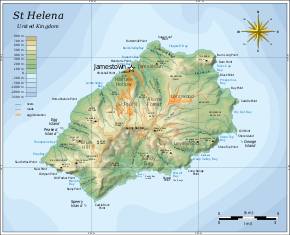
Back Saint Helena ACE Sint Helena Afrikaans St. Helena (Insel) ALS ሴይንት ህሊና ደሴት Amharic Isla Santa Helena AN Sancte Elene Īeg ANG سانت هيلينا Arabic سانت هيلينا ARZ Islla Santa Lena AST Müqəddəs Yelena adası Azerbaijani
Saint Helena | |
|---|---|
| Motto: "Loyal and Unshakable" | |
| Anthem: "God Save the King" | |
| Unofficial anthem: "My Saint Helena Island" | |
 Map of Saint Helena | |
 Location of Saint Helena in the southern Atlantic Ocean | |
| Sovereign state | |
| Colonial charter | 1656 |
| Crown colony | 22 April 1834[1] |
| Current constitution | 1 September 2009 |
| Capital | Jamestown 15°56′S 05°43′W / 15.933°S 5.717°W |
| Largest city | Half Tree Hollow 15°56′0″S 5°43′12″W / 15.93333°S 5.72000°W |
| Official languages | English |
| Demonym(s) |
|
| Government | Devolved parliamentary dependency under a constitutional monarchy |
• Monarch | Charles III |
• Governor | Nigel Phillips |
| Julie Thomas | |
| Legislature | Legislative Council |
| Government of the United Kingdom | |
• Minister | Stephen Doughty |
| Area | |
• Total | 121.8 km2 (47.0 sq mi) |
| Highest elevation | 820 m (2,690 ft) |
| Population | |
• 2021 census | 4,439[2] |
• Density | 36.5/km2 (94.5/sq mi) |
| Currency | Pound sterling Saint Helena pound (£) (SHP) |
| Time zone | UTC±00:00 (GMT) |
| Driving side | Left |
| Calling code | +290 |
| ISO 3166 code | SH-HL |
| Internet TLD | .sh |
Saint Helena (/ˌsɛnt (h)ɪˈliːnə, ˌsɪnt-, sənt-/, US: /ˌseɪnt-/[3][4]) is one of the three constituent parts of Saint Helena, Ascension and Tristan da Cunha,[5] a remote British overseas territory.
Saint Helena is a volcanic and tropical island, located in the South Atlantic Ocean, some 1,874 km (1,165 miles) west of the mainland of the continent of Africa, with the Southern African nations of Angola and Namibia on its southwestern coast being the closest nations geographically. The island is around 1,950 km (1,210 mi) west of the coast of southwestern South Africa, and 4,000 km (2,500 mi) east of the major seaport city of Rio de Janeiro, Brazil in South America.
Saint Helena measures about 16 by 8 km (10 by 5 mi) and had a population of 4,439 in the 2021 census.[2] It was named after Helena (AD c.246/248–330), influential mother of the famous Roman Emperor Constantine I (Constantine the Great). (A.D 272–337, reigned 306–337), of the ancient Roman Empire. It is one of the most remote major islands in the world and was uninhabited until the 16th century, when it was discovered by the Portuguese explorers/traders en route southward around the continent of Africa, then east across the Indian Ocean to the Indian subcontinent (India) of South Asia in 1502. For about the next four centuries, the island was an important stopover for ships between Europe and Asia sailing around the African continent and its southern Cape of Good Hope, before the opening of the shortcut Suez Canal in 1869, in Egypt between the Mediterranean and Red Seas. Saint Helena is the United Kingdom's second-oldest overseas territory / possession of the old British Empire, after the islands of Bermuda, off the southeast coast of North America. Until the opening of its airport in 2017, the primary method of reaching Saint Helena was a 6-day journey by sea, most recently since 1989 on the RMS St Helena passenger steamship liner.
Saint Helena is known for being the site of Napoleon Bonaparte's second and longest period of exile, following his final defeat in June 1815, until his death there six years later.
- ^ Cite error: The named reference
crown colonywas invoked but never defined (see the help page). - ^ a b "St-Helena at a Glance" (PDF). St Helena Government. 18 November 2021. Retrieved 30 November 2021.
- ^ Jones, Daniel (2011). Roach, Peter; Setter, Jane; Esling, John (eds.). "St Helena". Cambridge English Pronouncing Dictionary (18th ed.). Cambridge University Press. ISBN 978-0-521-15255-6.
- ^ "Saint Helena". Merriam-Webster.com Dictionary. Merriam-Webster.
- ^ "Constitution of St. Helena, Ascension and Tristan da Cunha". UK Archives. 2009. Archived from the original on 12 March 2010. Retrieved 21 July 2012.

